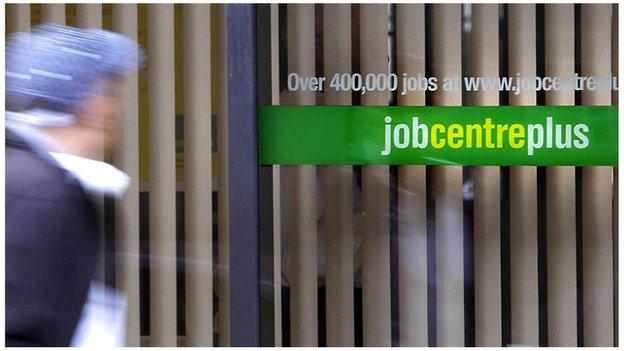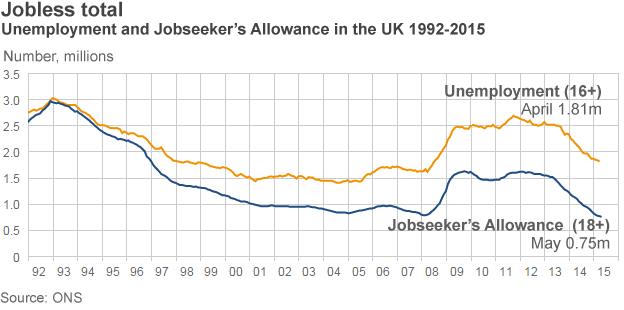UK unemployment falls as wages rise
- Published

UK unemployment has fallen again while wage growth has hit a near four-year high, official figures have shown.
The number of people out of work between February and April fell by 43,000 to 1.81 million, the Office for National Statistics said, external.
The jobless rate held steady at 5.5%, the lowest level since August 2008.
Meanwhile wage rises grew at their fastest rate since August 2011, rising 2.7%, both including and excluding bonuses.
The total number of people now in work is 31.05 million people, which is 114,000 more than in the previous three month period.
The employment rate for women hit a record high of 68.6%.

Robert Peston asks whether average wages in the UK will continue to rise
The government welcomed the ONS figures.
"Today's figures confirm that our long-term economic plan is already starting to deliver a better, more prosperous future for the whole of the country, with wages rising, more people finding jobs and more women in work than ever before," said Employment Minister Priti Patel, external.
But the unemployment rate for people aged from 16 to 24 remained higher than the rate for older age groups.
For the February to April period, the unemployment rate for this group was 16.1%.
'Premature move'
The pound rose to a one-month high against the US dollar at $1.57, as traders reacted to news that wages are rising more quickly than expected.
Many see the wage growth as a sign that interest rates may rise sooner than expected.
"The speed in the rise in earnings will embolden a minority on the Monetary Policy Committee who feel the urge to raise rates," said David Kern, chief economist at the British Chambers of Commerce.
"However, until there is firmer evidence of comparable increases in productivity, such a move would be premature.

Analysis: Anthony Reuben, head of statistics, BBC
It's important to remember that these are not precise figures.
The headline unemployment number comes from the Labour Force Survey, in which the ONS interviews about 40,000 people every quarter. That's a very big survey, but as with all surveys it means there is a margin of error.
In the case of the number of people unemployed, it means they are 95% sure that the estimate they have produced is no more than 78,000 out either way. So when they say their best estimate is of a 43,000 fall in unemployment, they mean that they are 95% sure that the actual figure is between a fall of 121,000 and a rise of 35,000. As we can't be 95% confident that unemployment has fallen at all, it means that today's reported drop in unemployment is not statistically significant.

Some economists also cautioned that strong wage growth might not continue indefinitely, with inflation running at just 0.1%, according to figures released on Tuesday.
"It's uncertain as to how much pay growth will continue to accelerate, as low inflation will hold down annual pay reviews," said Chris Williamson, chief economist at Markit.
- Published16 June 2015

- Published13 May 2015
